MP Board 12th Class Physics Important Questions Chapter 8 Electromagnetic Waves
Electromagnetic Waves Important Questions
Electromagnetic Waves Objective Type Questions
Question 1.
Choose the correct answer of the following:
Question 1.
The electromagnetic waves are produced due to :
(a) Accelecrated charge
(b) Charge at rest
(c) A charge moving with uniform speed
(d) Current carrying conduction.
Answer:
(b) Charge at rest
Question 2.
Which of the following is not an electromagnetic wave :
(a) X – ray
(b) Ultraviolet ray
(c) Beta rays
(d) Visible light.
Answer:
(c) Beta rays
![]()
Question 3.
Electromagnetic waves were first verified experimentally by :
(a) Maxwell
(b) Hertz
(c) Bose
(d) Marconi.
Answer:
(b) Hertz
Question 4.
The formula for the velocity of electromagnetic wave in vacuum is given by :
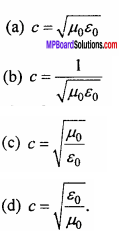
Answer:
![]()
Question 5.
The ozonosphere absorbs :
(a) Visible light
(b) Microwaves
(c) Infrared rays
(d) Ultraviolet radiations.
Answer:
(d) Ultraviolet radiations.
Question 6.
If in an electromagnetic wave the electric vector is along X – direction magnetic vector is along Y – direction then the direction of propagation will be :
(a) X – direction
(b) Y – direction
(c) Z – direction
(d) None of these.
Answer:
(c) Z – direction
Question 2.
Fill in the blanks :
- The sound waves are the longitudinal waves. The electromagnetic wave is …………….
- The electromagnetic waves are sinusoideal oscillations of ……………. and ……………. which are mutually perpendicular.
- The colour of visible light depends upon its …………….
- The ……………. rays are used as germ killer.
- The wave length range of visible light is …………….
- The electromagnetic wave having maximum frequency is …………….
- The waves having frequency of order of mega hertz are called as …………….
Answer:
- Transverse waves
- Electric and magnetic fields
- Frequency
- Ultraviolet
- 400 nm to 800 nm
- Gamma
- Radio waves.
Question 3.
Match the Column :

Answer:
- (b)
- (d)
- (e)
- (c)
- (a)
Question 4.
Write the answer in one word/sentence :
- Name the scientist who first predicted the existence of electromagnetic waves.
- Write the SI unit of displacement current.
- What is displacement current due to?
- Is displacement current like conduction current also a source of magnetic field?
- Write down Maxwell’s equations for steady magnetic field.
- Which of the following has the lowest frequency : microwaves, ultra – violet rays and X – rays?
Answer:
- James Clerk Maxwell
- The SI unit of displacement current is ampere (A)
- Displacement current exists due to a time – varying electric field or changing electric flux
- Yes, displacement current also produces a magnetic field
- (i) \(\int { \vec { B } .\vec { dS } }\) = 0
(ii) \(\int { \vec { B } .\vec { dl } }\) = 0.6. Microwaves.
Electromagnetic Waves Very Short Answer Type Questions
Question 1.
Answer the following questions in one word/one sentence :
- Who discovered electromagnetic waves?
- Are electromagnetic waves deflected by electric or magnetic field?
Answer:
- Maxwell
- No.
Question 2.
Write the formula by which the speed of electromagnetic waves can be determined in vacuum.
Answer:
Speed of electromagnetic wave is given by the formula :
c = \(\frac { 1 }{ \sqrt { { \mu }_{ 0 }{ \varepsilon }_{ 0 } } }\)
Where, µ0 = Permeability of free space and ε0 = Permittivity of free space.
![]()
Question 3.
How do the electric field and magnetic field propagate in space?
Answer:
In the space the electric field and magnetic field travel perpendicular to each othe also perpendicular to the propagation of wave.
Question 4.
What type of oscillation takes place in electromagnetic waves? Are they transverse or longitudinal?
Answer:
In electromagnetic waves, both electric field and magnetic field oscillate perpendicular to each other and also perpendicular to the direction of propagation of waves. They are transverse in nature.
Question 5.
- State the relation between the amplitudes of electric field and magnetic field of electromagnetic waves travelling through vacuum.
- The electromagnetic waves are transverse in nature, how?
Answer:
- c = E/B, where c is the speed of electromagnetic wave, E is amplitude of electric field and B is amplitude of magnetic field.
- The electric field and magnetic field are perpendicular to each other and also perpendicular to the direction of propagation of wave. Hence, electromagnetic waves are transverse in nature.
Question 6.
- What was the limit of wavelength of electromagnetic waves produced by Hertz?
- What was the limit of wavelength of electromagnetic waves produced by J.C. Bose ?
Answer:
- About 5 m,
- 5 to 25 mm.
Question 7.
Write the frequency of electromagnetic spectrum in ascending order.
Answer:
Radio waves, Microwaves, Infrared rays, Visible light, Ultraviolet rays, X – rays and γ – rays.
Question 8.
Arrange the following electromagnetic waves in ascending order of their wavelength.
Microwaves, γ – rays, radio waves, violet rays.
Answer:
γ – rays, violet rays, microwaves and radio waves.
Question 9.
Answer the following questions :
- What is the range of wavelength of visible rays?
- What is the wavelength of X – rays?
Answer:
- Wavelength of visible rays ranges from 4000 Å to 7800 Å.
- 1 Å to 100 Å.
![]()
Question 10.
Which waves are used as signals through fog and why?
Answer:
Infrared rays are used for signals through fog because its wavelength is greater and hence the scattering is least.
Question 11.
What is displacement current?
Answer:
When electric flux changes with time in vacuum or in medium, then it is equivalent to an electric current. This current is called displacement current.
Question 12.
What are electromagnetic waves? What is its nature?
Answer:
Electromagnetic waves:
Electromagnetic waves are those waves which are produced by the oscillating magnetic and electric fields perpendicular to one another and also perpendicular to the direction of propagation of waves. The nature of electromagnetic waves are transverse.
Question 13.
Write four properties of electromagnetic waves.
Answer:
- The electromagnetic waves are produced by oscillatory or accelerated charge.
- They are transverse in nature.
- They can propagate through vacuum.
- The speed of electromagnetic waves in vacuum is same as the speed of light (= 3 x 108m/s).
Question 14.
Dim red light is used in film developing room, why?
Or
Why red light is used in photographic room?
Answer:
The energy of photons of red light is less therefore, it hardly affects the films.
Question 15.
The bulbs of ultraviolet lamps are made up of quartz, why?
Answer:
The ultraviolet rays are absorbed by glass but not by quartz, therefore ultraviolet rays pass through quartz but not through the glass.
Question 16.
Optical telescope and radio telescopes are used in earth but X – ray telescopes are used in space, why?
Answer:
Visible rays and radio waves are not absorbed by atmosphere of earth while X – rays are absorbed, therefore X – ray telescopes can be used only in space or in satellite.
Question 17.
Had there been no atmosphere near to the surface of the earth, what would have been the surface temperature ? Answer with reasons.
Or
How would the absence of atmosphere affect the temperature of earth surface?
Answer:
The temperature of the earth would be lower because the green house effect of the atmosphere would be absent.
![]()
Question 18.
Where is the ozone layer situated in the atmosphere? What role it plays in the survival of human beings?
Or
How, the thin ozone layer is crucial for animal survival on earth?
Answer:
Ozone layer absorbs ultraviolet radiation coming from sun and other heavenly bodies and hence prevents it from reaching to the earth. Ultraviolet radiations cause genetic effect and damage the life of animals. Ozone layer is situated in between 30 to 50 km above the earth.
Question 19.
On what factors does the ionization of atmosphere depend?
Answer:
The state of ionization of atmosphere depends upon the ultraviolet rays coming from the sun and other heavenly bodies and also the height of atmosphere from the surface of earth.
Question 20.
What are the various ways by which radio waves can propagate?
Answer:
Radio waves can propagate from one place to the other on the earth by the following three modes in accordance with their frequency :
- By ground wave
- By space wave
- By sky wave.
Question 21.
What are ground waves?
Answer:
The radio waves transmitted from radio transmission travelling along the earth surface are called ground waves. The wavelength of 200 m and more than that are transmitted as ground waves. This is called as medium wave band.
Question 22.
On what factors does the transmission of ground waves depend?
Answer:
The transmission of ground waves depends upon :
Wavelength:
The wavelength of waves will be 200 m and more are transmitted as ground waves. The wavelengths less than 200 m are absorbed by earth.
The curvature of earth:
The earth surface is curved hence ground waves cannot be transmitted for far distance.
Question 23.
What are sky waves? Explain.
Answer:
Those radio waves which are transmitted through lower atmosphere but reflected by ionosphere are called sky waves. The radio waves in the frequency range from 1500 Hz to 40 MHz are propagated by this mode. This is called short – wave band.
Question 24.
Why artificial satellites are used for long distance T.V. communication?
Answer:
T.V. signals are not reflected by ionosphere, therefore these waves are reflected by satellite.
![]()
Question 25.
Write one use of each :
- Microwaves
- Infrared ray
- Ultraviolet rays
- Gama rays.
Answer:
- Microwaves : In radar.
- Infrared ray : Radiation purpose in some diseases.
- Ultraviolet rays : For killing germs.
- Gama rays : For treatment of cancer.
Question 26.
Write the type of radio wave and write its one use :
Answer:
Waves:
- Short radio wave
- Wireless wave
Uses:
- For propagation of radio and television signal
- In navigation and police radio transmission
Electromagnetic Waves Short Answer Type Questions
Question 1.
What are electromagnetic waves? Write their four properties. Draw suitable figure for showing direction of electric field, magnetic field and propagation of wave.
Or
What are electromagnetic waves? Write their main properties.
Answer:
Electromagnetic waves are those waves which are produced by oscillating magnetic and electric field perpendicular to each other and also perpendicular to the direction of propagation.
The properties of electromagnetic waves are :
- The electromagnetic waves are transverse in nature.
- They can travel through vacuum also.
- They are not affected by magnetic field and electric field.
- The velocity of electromagnetic waves in vacuum is constant i.e., 3 x108 m/s.
- These waves show the properties of reflection, refraction, interference, diffraction, polarization etc.
- These waves are produced by oscillating or accelerated charge.
- At every point in the space c = E/B, where c = Velocity of wave, E = Electric field and B = Intensity of magnetic field.
Question 2.
Write the differences between sound waves and electromagnetic waves.
Answer:
Differences between sound waves and electromagnetic waves :
Sound waves:
- They are mechanical waves.
- They are longitudinal waves.
- The sound waves do not show the the phenomenon of polarization.
- For the propagation of sound waves, medium is required.
- The velocity of sound waves is near about 332 m/s at 0°C in air.
Electromagnetic waves:
- They are not mechanical waves.
- They are transverse in nature.
- Electromagnetic waves show the pheno – menon of polarization.
- Electromagnetic waves can travel in vacuum. For propagation of electromagnetic waves, medium is not required.
- Its velocity is very high; about 3 x 108 m/s.
Question 3.
What is electromagnetic spectrum? Write down the name of different type of spectrum and their uses. (One use for each constituent of spectrum)
Answer:
The array obtained on arranging all the electromagnetic waves in order, on the basis of their wavelength is called electromagnetic spectrum. In order of increasing wavelength they are :
- Gamma rays
- X – rays
- Ultraviolet radiation
- Visible light
- Infrared radiation
- Microwaves
- Radio waves.
Uses of electromagnetic spectrum :
- γ – rays : To kill unwanted cell in the treatment of cancer.
- X – rays : To detect broken bones and to study the structure of crystals.
- Ultraviolet rays : To kill the germs, to detect the purity of ghee, diamond and jewels.
- Visible rays : To see the objects.
- Infrared rays : To use as signals during war, in photography at night or in mist or fog, for therapeutic purpose by the doctors.
- Microwaves (Hertzian waves) : In Radar, television, microwave oven.
- Radio waves (Wireless waves): In television, navigation and polic radio transmission.
![]()
Question 4.
Write the uses of different region of electromagnetic spectrum.
Answer:
Uses of electromagnetic spectrum :
- γ – rays : To kill unwanted cell in the treatment of cancer.
- X – rays : To detect broken bones and to study the structure of crystals.
- Ultraviolet rays: To kill the germs, to detect the purity of ghee, diamond and jewels.
- Visible rays : To see the objects.
- Infrared rays : To use as signals during war, in photography at night or in mist or fog, for therapeutic purpose by the doctors.
- Hertzian waves : Radio and T. V. transmission.
- Wireless waves : In navigation and police radio transmission.
Question 5.
Why electromagnetic waves when strike a surface exerts pressure on it?
Answer:
Electromagnetic waves carry momentum, so it exerts pressure on surface when strike on it.
Question 6.
What are micro waves? State one of its important uses.
Answer:
The waves whose order of wavelength in few milimetre are called microwaves. It is used in radar system.
Question 7.
Write the names of the scientists who discovered the different constituent of electromagnetic spectrum.
Answer:
The scientists who discovered the different constituents are as follows :
- γ – rays : Becquerel
- X – rays : Roentgen
- Ultraviolet rays : Ritter
- Visible rays : Newton
Question 8.
Describe the Hertz’s experiment of the production of electromagnetic waves in following points:
- Labelled diagram of apparatus
- Experimental arrangement.
Answer:
It consists of two parallel plates P1, and P2 connected to two metal spheres S1 and S2. The distance between P1 and P2 is 60 cm. The gap between S1 and S1 can change by sliding along the rods R1 and R2.R1 and R2 are connected to the terminals of the secondary coil of an induction coil, so that a high voltage can be establi shed between S1 and S2 and spark between the gap is produced, P1 and P2 form a capacitor of low capacitance.
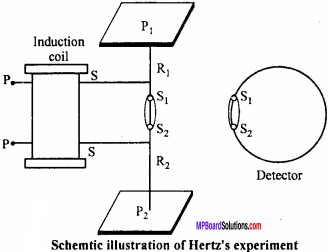
D is a detector. When the charge starts oscillating, between the gap, series of sparks are produced. This results in the production of electromagnetic waves. These radiations are received by detector D.
Question 9.
What is displacement current? Why was this concept introduced?
Answer:
Displacement current:
It is that current which comes into existence (in addition to conduction current) whenever the electric field and hence the electric flux changes with time. It is equal to s0 times the rate of change of electric flux through a given surface
Id = ε0\(\frac { d{ \phi }_{ E } }{ dt }\) = ε0A\(\frac {dE}{ dt }\)
Maxwell introduced the concept of displacement current for the following reasons :
- To make the Ampere’s circuital law logically consistent.
- To satisfy the property of continuity of electric current along any closed path.
Question 10.
Prove that ID = ε0\(\frac {d}{ dt }\)ϕE, where the symbols have usual meaning.
Answer:
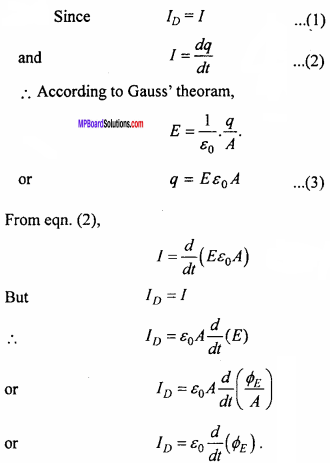
Question 11.
What conclusion can be drawn between displacement current and conduction current?
Answer:
Like conduction currents displacement current is also a source of magnetic field. Both the current are equal to each other. Displacement current is originated due to charge in electric field between two plates of a condensor. ID current is in between the two plates of condensor whereas conduction current is in the wire connecting both plates and is a source of electromotive force.
Electromagnetic Waves Long Answer Type Questions
Question 1.
Describe different components of electromagnetic spectrum.
Answer:
Electromagnetic waves have a large range of wavelength and frequency. When Maxwell predicted about the existence of electromagnetic waves at that time he was aware of visible light only. Gamma rays, X – rays, UV – rays and infrared rays were discovered at the end of 19th century. Later on radio waves and microwaves came into existence. So, electromagnetic waves have a large frequency or wavelength range.
All these electromagnetic wayes have general properties. But they do have some individual features. So, the classification on the basis of frequency or wavelength is called “Electromagnetic spectrum”. “An orderly arrangement of radiations according to wavelength (or frequency) is called electromagnetic spectrum”. Names of rays in decreasing frequency and increasing wave length are as follows :
- Gamma rays (y rays)
- X – rays (X – rays)
- UV rays
- Visible rays
- IR rays
- Microwaves
- Radio waves
Following facts related to electromagnetic spectrum are to be remembered.
1. Gamma rays:
These rays were discovered by Henery Becqurel in 1896. These rays have frequency from 1018 Hz to 1022 Hz (i.e., from wavelength 10-14 m to 10-10 m).
Production / generation:
The rays are produced due to nuclear reactions, radioactive elements like uranium and radium emit these rays by themselves.
Properties:
- These rays affect photographic plates.
- These rays ionize gases.
- These rays produce luminiscence.
- These rays have high penetration power.
Uses:
- Making polythene from Enelene.
- To detect the nuclear structure.
- In destroying unwanted celis.
- In treatment of cancer.
2. X – rays:
These rays were discovered by Rontegen in 1895. These rays have frequency from 1016 Hz to 1020 Hz (or wavelength from 10-13 m to 102 m).
Production:
These rays are produced by bombarding of electrons on heavy metals.
Properties:
- These rays affect photographic plate.
- These rays ionize gases.
- These rays produce luminiscence.
- These rays have less penetration power as compared to Gamma rays.
X – rays can penetrate human body, but can be obstructed by bones and metallic materials.
Uses:
In medical investigation, like in the detection of fractured bone, the presence of metallic things in the body such as coin, bullet etc.
- In the study of crystalline structure.
- In the treatment of cancer and tumour.
- In the engineering field, in detecting cracks and defects etc.
- They are used in metal detector in restricted are as to find the prohibited things.
3. Ultraviolet rays:
These rays were discovered by J. W. Ritter in year 1801. These waves have frequency from 7.5 x 1014 Hz to 5 x 1017Hz (or wavelength from 6 x 10-10m to 4 x 10-7m.)
Production:
Ultraviolet rays are generated from discharge tube or carbon arc etc. Sun is an important source of ultraviolet rays. These rays are absorbed by ozone layers before reaching to atmosphere.
Properties:
- These rays affect photographic plate and are more active in visible region for chemical changes.
- These rays also produce fluorescence.
- These rays show photoelectric effect.
- These rays ionize the gases.
Uses:
- In killing micro-organisms of diseases.
- Producing photoelectric effect.
- In detection of jewels, gems, fresh eggs and of pure Ghee.
- In detection of finger print.
- In preservation of food materials.
4. Visible light:
It has frequency from 4 x 1014 Hz to 7 x 1019 Hz (or wavelength from 4 x 10-7 m to 7.8 x 10-77).
Production:
Sun is main source of visible light. The light obtained from electric bulb, candle and eye lamp is visible light. It is emitted when atoms of excited state reach to the ground state. It was first studied by Newton in 1966. The visible spectrum has many colour, the prominent being violet, indigo, blue, green, yellow, orange and red.
Properties:
- The visible light produces sight sensitivity.
- It shows chemical effect. As a consequence, it affects the photographic plate.
- The visible light shows photoelectric effect.
5. Infrared rays:
These rays were discovered by William Herschell in 1800. These rays have frequency from 3 x 1011 Hz to 4.0 x 1014Hz (or wavelength from 7.8 x 10-7 to 10-3m).
Production:
Infrared rays are produced by hot bodies and molecules. So, these are also called thermal rays.
Properties:
- These rays show thermal effect.
- Due to greater wavelength, these rays get less scattered, so these rays can be propagated up to long distances in fog also.
- These rays do not affect photographic plate.
Uses:
- Infrared lamps are used in treatment of diseases.
- These rays are also used in photography in dark because these rays do not affect photographic plate.
- To send signals from one place to another in fog and mist, because they have longer wavelength so their scattering is least and penetrating power is high.
- These rays are used to produce greenhouse effect.
6. Microwaves:
These waves were discovered in 1888 by Hertz. These rays have frequency from 109 Hz to 1012 Hz (i.e., wavelength from 10-3 m to 0.3 m.). These are short wavelength radio waves.
Production:
These rays are produced in special type of vacuum tube like magnetron, klystron etc.
Properties:
These rays have very short length. So, they do not get diffracted by the obstruction of large size. These rays move forward in the form of a narrow beam of rays. So, these rays can be sent in a certain direction without any expansion.
Uses:
- These waves are mainly used in Radar system and Remote communication.
- These waves are detected by crystal detectors or semiconductors diode.
7. Radio waves:
These rays were discovered in 1899 by Marconi. Frequency of these waves are generally measured in kHz or MHz. These rays have frequency from 500 kHz to 1000 MHz or wavelength from 0.1 m to 6 x 102 m. These waves are also called wireless rays.
Production:
These waves can be produced by oscillator circuit and can also be produced by passing high frequency alternating current through any conductor.
Properties:
Due to higher wavelength, they get diffracted.
Uses:
- These waves are used in radio or TV communication as follows :
- 530 kHz to 1710 kHz radio waves are used in amplitude modulation.
- 54 MHz high frequency short waves are used in radio bands.
- From 50 MHz to 890 MHz waves are used as television rays.
- From 88 MHz to 108 MHz waves are used in frequency modulation.
Electromagnetic Waves Numerical Questions
Question 1.
A parallel plate capacitor has circular plates, each of radius 5.0 cm it is being charged so that electric Field in the gap between its plates rises steadily at the rate of 1012 Vm-1 s-1. What is the displacement current? (NCERT)
Solution:
Here r = 5 cm = 5 x 10-2 m,
\(\frac {d}{ dt }\) = 1012 Vm-1 s-1 dt
Displacement current,
Id = ε0\(\frac { d{ \phi }_{ E } }{ dt }\) = ε0 A \(\frac {dE}{ dt }\)
= ε0.πr2 \(\frac {dE}{ dt }\)
= 8.85 x 10-12 x π x(5 x 10-2) x 1012 A
= 0.07 A.
![]()
Question 2.
The voltage between the plates of a parallel – plate capacitor of capacitance 1.0µF is changing at the rate of 5 Vs-1. What is the displacement current in the capacitor? (NCERT)
Solution:
Here C = 1.0µF = 1.0 x 10-6F,
\(\frac {dV}{ dt }\) = 5Vs-1
Displacement current,
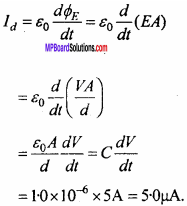
Question 3.
Electromagnetic waves travel in a medium at a speed of 2.0 x 108ms-1. The relative permeability of the medium is 1.0. Find the relative permittivity.
Solution:
Speed of an electromagnetic wave in a medium is given by
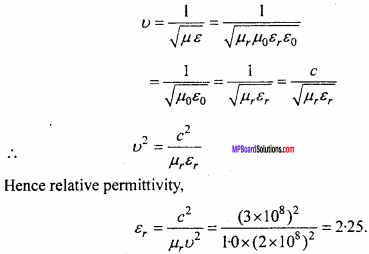
Question 4.
A plane electromagnetic wave of frequency 25 MHz travels in free space along the X – direction. At a particular point in space and time, \(\vec { E }\) = 6.3\(\hat { j }\) Vm-1. What is \(\vec { B }\) at this point?
Solution:
Magnitude of \(\vec { E }\),E = 6.3 Vm-1.
Magnitude of \(\vec { B }\) ,

We note that E is along Indirection and the wave propagates along X – direction. Now an electromagnetic wave propagates in the direction of the vector \(\vec { E }\) x \(\vec { B }\). So this vector must point along X – direction.
